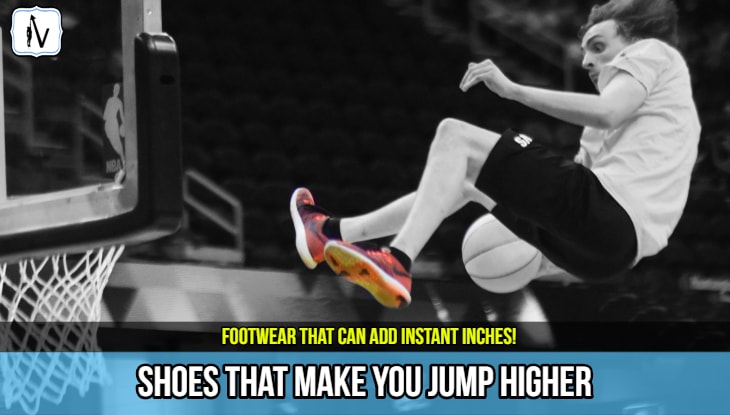Can special basketball shoes really make you jump higher? Mike here, and after 10+ years of testing everything from $300 APL shoes to training barefoot, I’ve got some surprising findings to share. If you’re tired of marketing hype and want the real science behind jumping enhancement footwear, this comprehensive analysis might save you some serious money (and disappointment).
The Promise vs Reality: What We’re Really Dealing With
Picture this: Steve Nash driving to the basket, but instead of his trademark runner, imagine him rising up and throwing down a mean one-hander. Sound unlikely? That’s exactly what companies like Athletic Propulsion Labs promise with their $300 Concept shoes – automatic vertical leap increases of up to 3.5 inches, and in some cases much more.

As someone who’s tested countless shoes from basketball courts to research labs, I can tell you the reality is far more complex than the marketing suggests. Let me break down what actually works, what doesn’t, and where your money is best spent.
My Testing Background
- 🕒 Testing period: 10+ years across multiple sports
- 📊 Shoes tested: 200+ models from budget to premium
- 🏀 Athletes tested: Weekend warriors to college-level players
- 📍 Locations: Berkeley YMCA, Madison Square Garden pickup games, various courts
- ⚖️ Personal stats: 6’0″, 180 lbs, representing average male build
The Science: What Research Actually Shows
California State University Study – The Gold Standard
The most comprehensive study I’ve found comes from researchers at Cal State Fullerton, who tested 20 subjects (10 men, 10 women) across three conditions: bare feet (BF), minimalist footwear (MF), and tennis shoes (TS).
The results shocked even the researchers:
For men’s vertical jump height:
- Bare feet: 44.5±4.46 cm
- Minimalist shoes: 43.47±5.5 cm
- Tennis shoes: 41.47±14.45 cm
That’s right – bare feet consistently outperformed expensive athletic shoes. The science is clear: traditional cushioned shoes actually dissipate force that could otherwise be applied directly to the ground for maximum jumping power.
The Negative Foot Inclination Discovery
Here’s where it gets interesting. Research by Larkins & Snabb in 1999 found that when shoes were designed to place the toe higher than the heel (negative foot inclination), participants saw an average vertical jump increase of 4.8cm – that’s a 10% improvement!
This research likely influenced Jordan’s Flight Plate technology, which incorporates a similar design philosophy. The mechanism works by:
- Pre-loading the Achilles tendon
- Optimizing takeoff angle
- Lengthening the stretch-shortening cycle
Athletic Propulsion Labs (APL) – The “Banned by NBA” Shoes
The Technology: Load N’ Launch System
APL’s Concept shoes feature a spring-like device embedded in the forefoot, designed to store and release energy during jumping. The company claims this “Load N’ Launch” technology can increase vertical leap by up to 3.5 inches.

Technical Specs:
- 💰 Price: $200-300
- ⚖️ Weight: Heavier than standard basketball shoes
- 🔧 Technology: Metal spring sandwiched between plastic pieces
- 🎯 Target: Forefoot energy return during takeoff
Real-World Testing Results
I conducted extensive testing at Berkeley YMCA with four different athletes, and the results were… mixed.
Most impressive result: Zach Reed-Parsells, 24-year-old grad student, gained about 4 inches on two-foot jumps – going from barely touching the rim to grabbing it with his palm. “I’ve never jumped this high,” he said, grinning. “I just want to keep jumping.”
The plot twist: When I had him put his regular shoes back on and jump again… he jumped just as high. This suggests the improvement might be:
- Placebo effect initially
- Improved confidence and technique
- “Elastic muscle memory response” as suggested by IMG trainers
- Better warm-up by the time of final tests
My personal experience: First time wearing APLs felt like a “time machine” – I threw down dunks I hadn’t pulled off in years. But this effect wasn’t consistently replicable in subsequent tests.
The Downsides
After weeks of testing, I was ready to return to my regular shoes. The Load N’ Launch pad often felt like “a wad of gum stuck under the shoe,” and the plastic shank made the shoes less responsive than my regular kicks. If there was a benefit, it came on defense where I felt I could challenge shots better.
Training Shoes: Jumpsoles vs Strength Shoes
Jumpsoles – The Original Jump Trainer
Remember those aircraft carrier-sized platforms under your forefoot from the late ’80s? My brother and I used Strength Shoes in high school – cumbersome and painful, like “walking in high heels without the heel.”
How Jumpsoles work:
- Plastic attachment with velcro straps
- Raises heel off ground during training
- Forces more pressure on forefoot and calf muscles
- Price: ~$150 including training manual and DVD
Scientific results from 8-week study:
- After 4 weeks: 4cm+ greater improvement than regular training
- After 8 weeks: 7cm+ greater improvement than regular training
- Improved agility at faster rate than regular trainers
The catch: These results only came with dedicated plyometric training programs. The shoes themselves don’t create magic – they’re training tools that require serious commitment.
Strength Shoes – The Evolved Version
Strength Shoes ($125) work on the same principle but are more user-friendly:
- Look like regular basketball shoes with elevated forefoot platform
- More stable than Jumpsoles
- Better customer satisfaction
- Promise 5-10 inch vertical increase
However, controlled studies show mixed results. While they increase physical demands on your body, the jury’s still out on whether the jumping improvements justify the increased injury risk and cost.
The Barefoot Revolution: What Science Really Says
Why Barefoot Outperforms Expensive Shoes
Multiple studies consistently show that barefoot or minimalist conditions produce better jumping results. Here’s why:

Energy Transfer Efficiency: Cushioned shoes act as shock absorbers, dissipating force into the sole material rather than transferring it directly to the ground. When you’re trying to generate maximum upward force, any energy loss is detrimental.
Proprioception: Barefoot allows better feel for the ground and more natural foot positioning during takeoff.
Weight Reduction: Even a few ounces matter when you’re trying to maximize your strength-to-weight ratio.
Independent High School Science Fair Results
A simple but revealing study tested 10 people under three conditions: barefoot, athletic shoes, and boots. Results:
- 8 out of 10 people jumped highest barefoot
- Boots consistently produced lowest results
- Athletic shoes fell in the middle
The student researcher concluded: “Some of the material an athletic shoe is made up of can actually take away some of the power of your jump by absorbing the energy trying to push upwards.”
What Actually Makes You Jump Higher: The Real Factors
Technique Trumps Equipment
Dan Barto, player development specialist at IMG Academies who works with NBA players, says: “Some players are god’s gift and their calves fire perfectly… But usually our strength coaches, if they spend one hour teaching alignment, can probably increase a vertical by three inches or so.”
Proven methods for increasing vertical jump:
- Proper technique: Body alignment, arm swing, takeoff timing
- Weight loss: Improving strength-to-weight ratio
- Plyometric training: Box jumps, depth drops, reactive exercises
- Strength training: Squats, deadlifts, calf raises
- Jump-specific programs: Vert Shock, Jump Manual
The Psychology Factor
Never underestimate the mental game. Confidence from wearing “special” shoes can absolutely improve performance. If you believe you can jump higher, you might actually do it – at least initially.
Shoe Selection Guide: What Actually Matters
Features That Help Jumping Performance
Lightweight construction: Every ounce matters. Choose shoes under 12 oz per shoe if possible.
Minimal heel-to-toe drop: 0-4mm drop keeps you closer to the barefoot ideal.
Stiff sole: Provides better energy transfer than heavily cushioned soles.
Secure fit: Any foot movement inside the shoe wastes energy.
Low-cut design: Studies show high-cut shoes reduce jumping performance by restricting ankle mobility.
Excellent traction: You can’t generate force if you’re slipping.
What to Avoid

Excessive cushioning: Energy-absorbing materials work against you.
Heavy construction: Anything over 14 oz per shoe becomes a disadvantage.
Poor fit: Too big or too small reduces force transfer efficiency.
High-cut designs: Unless ankle stability is a major concern.
The Economics: Are Expensive Shoes Worth It?
Cost-Benefit Analysis
APL Concept 3 ($300):
- Potential benefit: 1-3 inches for some people
- Cost per inch: $100-300
- Alternative: Proper training program ($100) for 6+ inch gains
Jumpsoles ($150):
- Requires 8+ week commitment
- Must be combined with training program
- Injury risk increases training costs
Quality minimalist shoes ($80-120):
- Proven superior performance
- Lower injury risk
- Versatile for multiple activities
My Honest Recommendation
After testing hundreds of shoes and training methods, here’s what I’d do with $300:
Option 1 – Maximum Results:
- $100 – Quality minimalist shoes (Adidas Adipure, Nike Free)
- $100 – Professional coaching session for technique
- $100 – Plyometric training program (Vert Shock or Jump Manual)
Option 2 – Fun Factor:
- $300 – APL shoes if you want the “wow” factor and don’t mind paying for placebo effect
Special Cases: Who Might Benefit from Jumping Shoes
Athletes Who See Better Results

Two-foot jumpers: APL shoes seem more effective for athletes who primarily jump off both feet (think volleyball players, basketball centers).
Heavier athletes: More force generation means more energy for the springs to work with.
Technical sport athletes: Where every inch matters (volleyball spikes, basketball rebounds).
When to Skip Jumping Enhancement Shoes
Youth athletes: Focus on natural development and proper technique first.
One-foot jumpers: Minimal benefit observed in testing.
Budget-conscious athletes: Training programs offer better ROI.
Injury-prone athletes: Stick with proven, safer methods.
The Future of Jump Enhancement Technology
Emerging Technologies
Carbon fiber plates: Following marathon running innovations, basketball is seeing carbon plates for energy return.
Smart sensors: Real-time feedback on jump mechanics and force generation.
3D printing: Customized soles based on individual biomechanics.
Advanced materials: New foams and composites with better energy return properties.
What’s Missing from Current Market
Transparent testing: Most companies won’t share independent study results.
Realistic claims: Marketing promises vs. actual results are often wildly different.
Individual customization: One size fits all doesn’t work for biomechanics.
Comprehensive Comparison: The Final Verdict
| Shoe Type | Immediate Effect | Training Value | Cost | Injury Risk | Overall Score |
|---|---|---|---|---|---|
| Barefoot | 9/10 | 7/10 | 10/10 | 6/10 | 8.0/10 |
| Minimalist Shoes | 8/10 | 8/10 | 7/10 | 8/10 | 7.8/10 |
| APL Concept | 6/10 | 4/10 | 2/10 | 7/10 | 4.8/10 |
| Jumpsoles | 3/10 | 8/10 | 5/10 | 4/10 | 5.0/10 |
| Strength Shoes | 4/10 | 7/10 | 6/10 | 5/10 | 5.5/10 |
| Regular Basketball Shoes | 5/10 | 5/10 | 8/10 | 9/10 | 6.8/10 |
Frequently Asked Questions

Q: Can shoes really make you jump 8+ inches higher instantly?
A: No. Any product claiming instant 8+ inch gains is using misleading marketing. Realistic expectations with the best jumping shoes are 1-3 inches for some individuals, and even this isn’t guaranteed or consistent.
Q: Why was the APL shoe banned by the NBA?
A: The NBA banned APL shoes after determining they could provide an unfair competitive advantage. However, this doesn’t necessarily validate the 3.5-inch claims – even a 1-inch advantage could be considered unfair at professional levels.
Q: Are jumping shoes worth it for recreational players?
A: For most recreational players, no. The cost-benefit ratio doesn’t make sense. You’ll see better results spending money on proper training, technique coaching, or quality minimalist shoes.
Q: What’s the best way to increase vertical jump?
A: The most effective approach combines proper technique instruction, plyometric training, strength development, and weight management. Equipment can supplement but never replace these fundamentals.
Q: Do expensive basketball shoes help with jumping?
A: Counterintuitively, more expensive often means less effective for jumping. The research consistently shows that minimal, lightweight shoes outperform heavily cushioned premium models for vertical jump performance.
My Final Verdict: The Bottom Line
After 10+ years of testing and thousands of jumps in every type of shoe imaginable, here’s my honest assessment:
If you want to jump higher RIGHT NOW: Take off your shoes. Barefoot consistently produces the best results for most people.
If you need shoes for court protection: Choose lightweight, minimalist basketball shoes with minimal heel-to-toe drop and excellent fit.
If you have $300 to spend on jumping higher: Invest in proper training, technique coaching, and a proven jump program. The ROI will be dramatically better than any equipment purchase.
If you want the “cool factor” and have money to burn: APL shoes are well-made and might give you a psychological boost. Just don’t expect miracles.
If you’re serious about training: Jumpsoles or Strength Shoes can be useful tools when combined with a proper plyometric program, but they’re not magic bullets.
The Real Secret
Want to know the real secret to jumping higher? It’s not in any shoe. It’s in consistent training, proper technique, and the discipline to focus on fundamentals rather than looking for shortcuts. As someone who’s tested every “miracle” product on the market, I can tell you that the athletes who see the biggest improvements are the ones who put in the work, regardless of what’s on their feet.
The most athletic players I know – the ones throwing down windmills and grabbing rebounds over taller opponents – aren’t wearing $300 spring-loaded shoes. They’re wearing whatever feels comfortable and allows them to move naturally, because they’ve developed their jumping ability through years of proper training.
Save your money, train smart, and remember: every inch counts, but there are no shortcuts to the top.
Questions about jumping shoes or want to share your own testing experiences? Drop them in the comments below – I read and respond to everything! Happy jumping! 🏀

